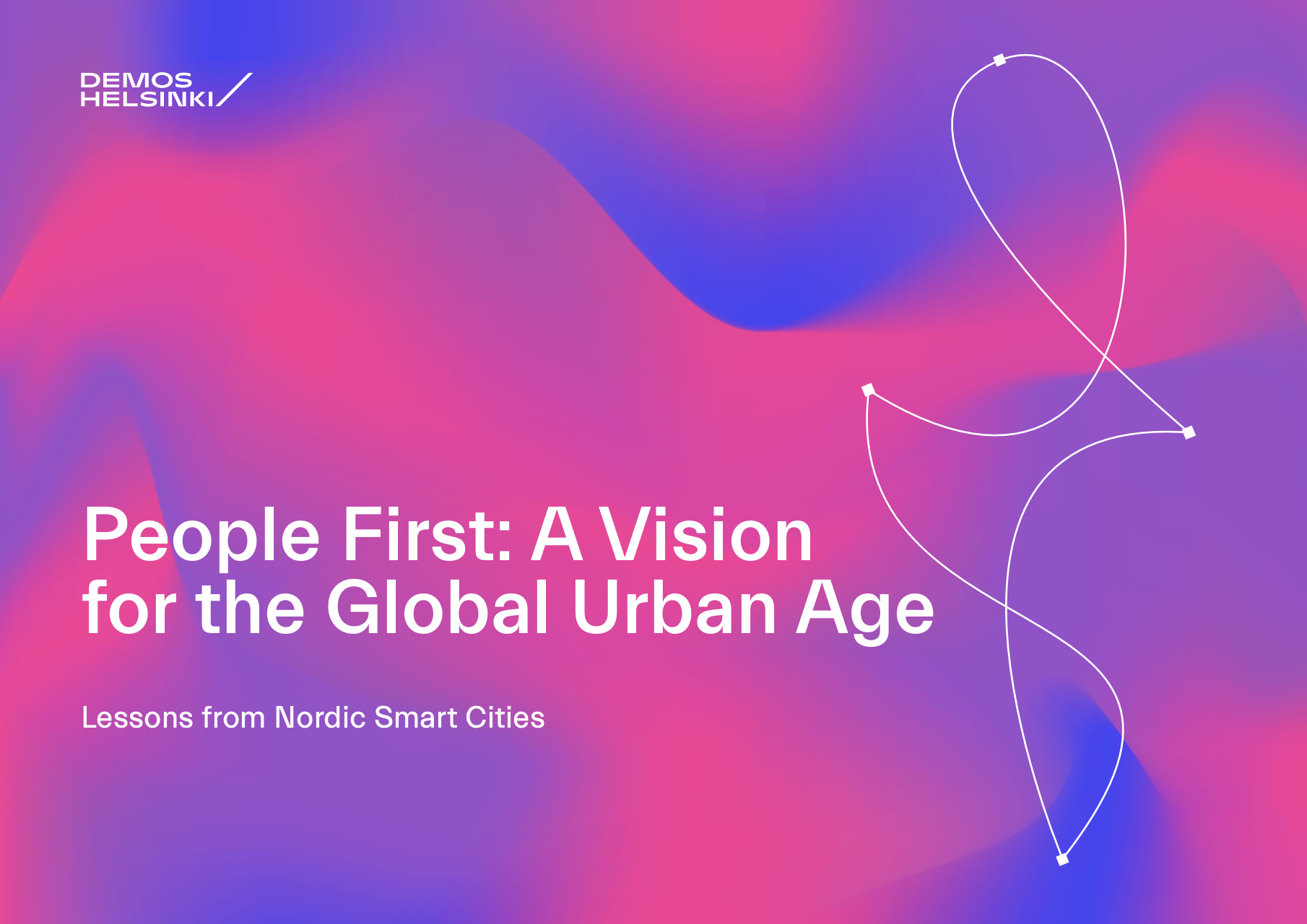Nordic lessons for people-first smart cities

People First: A Vision for the Global Urban Age. Lessons from Nordic Smart Cities
by Olli Bremer, Niko Kinnunen, Johannes Koponen, Louna Laurila, Juha Leppänen, Maria Malho, Roope Mokka, Henrik Suikkanen
Demos Helsinki publications
June 2020, 104 pages
> Announcement
Abstract
While it is argued that smart city development is at an impasse, we argue that it is at a crossroads. It is possible to simultaneously develop and adopt new technologies and strengthen people’s rights. This has been proven in the Nordic cities and Barcelona. The People-first vision presented in this report shows how it is possible for all cities.
The People-first vision is a new perspective to how cities can govern and benefit from digital technologies in the global urban age, by developing people’s rights and technologies in harmony. It is based on an analysis of different ways of how this is done in Nordic cities, Nordic city networks, and in Barcelona.
The People-first vision offers an alternative to technocratic governance models that are, on the one hand, being criticised for their inclination to compartmental optimisation and, on the other hand, contributing to breaches of privacy and narrowing human rights. In the People-first vision, the mandate for governance comes directly from the people itself and hence, the technological tools are used respecting their rights.
Executive summary
The smart city development is at a critical crossroads, where power and politics have become central to the way digital technologies are used in cities. The vast criticism of digital technologies being used to monitor, control and even manipulate people, and to centralise and take power away from citizens and public administrations, is risking the legitimacy of the smart city project. What has been the key function of the smart city project – using digitalisation to seek efficiencies in various city operations – has given way to a new phase with competing models for governing the city and the citizens.
Despite the discontinuity of the smart city development, the promise of digital technologies and operating models for cities is unparalleled. It is most evident in driving efficiency of the built environment and other urban infrastructure which offers new ways to govern urban dwellers and foster collaboration. This is a critical element of a well-functioning city of the 21st century so the need for digital tools is not going away.
There is a number of cities that show us glimpses of how the new phase of city governance could look like by actively leading their smart city ecosystems and by putting people first. In this report, the case studies of Nordic cities (Espoo, Helsinki, Tampere, and Vantaa), a city network (Nordic Smart City Network), as well as the City of Barcelona in Spain demonstrate that cities that want to take full benefit of digital technologies have to give them sufficient priority in the city organisation, move from facilitating smart city ecosystems to leading them, and recognise that different sectors of society – civic, public, and corporate – all have unique ways of creating value.
The report thus promotes a new, Nordic-born yet universally applicable way of governing digital technologies and using them to govern a city. What is presented here is not another smart city model but an alternative to the existing approaches: a new narrative of how cities can benefit from digital technologies. The narrative defines three fundamental characteristics of smart city governance that protect and promote people’s interests in a city. The three characteristics of people-first city governance are:
- Unbounded: City governance is cross-sectoral, highly networked and organised around people’s life events and universal services rather than public sector departments.
- Vision-driven: Smart city initiatives drive the city’s long term and strategic goals (and vice versa), the city leaves space for experimenting with new initiatives, and the user point of view is in harmony with the ideal of active citizenship.
- Regenerative: The city aims to empower people and allow “emergence” of digital technologies, strengthens democracy through innovations in participation and digital markets, and creates services that allow competition and real choice
These three characteristics in the cases studied explain how Nordic cities, in particular, have managed to maintain the high usability of digital services along with promotion of people’s voluntary action.
As the smart city project has been the de facto development paradigm for cities since the 2000s, the insights gained in this study yield a wider lesson to governing cities in the urban age. The discontinuity of the smart city development is symptomatic of a far deeper change in how cities are governed.
In city governance, there is an apparent move away from the passive ecosystem facilitation role to more active modes of governance. As a consequence, different and competing ideas and ideals are emerging. The main competitors to the way of governing presented in this report are the so-called Chinese authoritarian model where states and regions hold large powers, and the so-called Silicon Valley platform model where big technology companies take the responsibilities of the city. The People-first vision unites the powers of the city organisation and the urban dwellers in order to govern global issues such as digitalisation, climate change, and migration without giving away the democratic powers to, for example, the state or the private companies.
The People-first vision essentially introduces a new philosophy for the strategic management of cities based on the ideas of active citizenship and ecosystem leadership. In practice, the People-first vision enables cities to show direction and lead the ecosystems instead of just facilitating or orchestrating them. It gives cities a better view of the interactions of people, markets, and the public sector than the current public-private-(people) partnerships provide.
The People-first vision also allows city administrations to form alliances with other cities and regional or international organisations that go beyond just sharing best practices. Most importantly, it gives the grounds for city organisations to abandon the view that public services alone create wellbeing and begin to see the potential and assets of the whole urban ecosystem.



